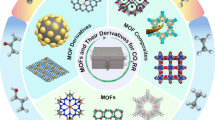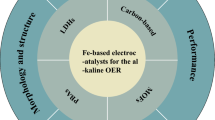Abstract
In this work, carbon-supported cobalt–dicyandiamide (Co–DCD) was synthesized by a simple chemical method followed heat-treated at 600,700, 800, 900, and 1000 °C to acquire electrocatalysts with excellent activity for the oxygen reduction reaction (ORR). The resulting catalysts Co–N/C–T pyrolyzed at 600–1000 °C all showed substantial activities to ORR, and the catalyst heat-treated at 800 °C exhibited the best ORR activity. The catalytic performance of Co y –N x /C 0.25–T catalysts synthesized with different amounts of DCD as nitrogen source and Co(OAc)2⋅4H2O as metal precursor were measured by cyclic voltammetry in alkaline electrolyte. The onset potential for oxygen reduction on the optimum catalyst was approximately 0.938 V (vs. RHE) in 0.1 M NaOH solution, higher by 83 mV than that on the commercial catalyst of 20 % JM Pt/C. Fourier transform infrared spectroscopy, X-ray diffraction, and X-ray photoelectron spectroscopy were used to characterize the catalyst in terms of the structure and composition in order to sketch the contours of the catalytic active sites of the catalysts. The characterization studies indicate that pyridinic N–C was the most important of the catalytic active sites and responsible for the ORR catalytic activity of Co–N/C–T in alkaline electrolyte. Cyclic voltammetry (CV) and linear sweep voltammetry (LSV) was also used to obtain the overall ORR electron transfer number and electron transfer coefficiency. The overall electron transfer number for ORR catalyzed by the optimum catalyst Co0.2–N2.35/C0.25–800 was determined to be 3.47 by CV and 3.89–3.96 by LSV,respectively, suggesting that the ORR was a mixture of two- and four-electron transfer pathways, but dominated by a four-electron transfer process. Based on these measurements and other references, an ORR mechanism was proposed to facilitate further investigation. The results also show that this novel catalyst with ORR excellent activity would have outstanding methanol tolerance and potential application as a kind of nonprecious metal cathodic ORR catalyst for direct methanol fuel cell.










Similar content being viewed by others
References
Greeley J, Stephens IEL, Bondarenko AS, Johansson TP, Hansen HA, Jaramillo TF, Rossmeisl J, Chorkendorff I, Nørskov JK (2009) Nat Chem 1:552–556
Qiao JL, Xu L, Ding L, Zhang L, Baker R, Dai XF, Zhang JJ (2012) Appl Catal B 125:197–205
Calle-Vallejo F, Martínez JI, Rossmeisl J (2011) Phys Chem Chem Phys 13:15639–15643
Chen RR, Li HX, Chu D, Wang GF (2009) J Phys Chem C 113:20689–20697
Ikeda T, Boero M, Huang SF, Terakura K, Oshima M, Ozaki J (2008) J Phys Chem C 112:14706–14709
Lee DH, Lee WJ, Kim SO, Kim YH (2011) Phys Rev Lett 106:175502–175505
Lee KR, Lee KU, Lee JW, Ahn BT, Woo SI (2010) Electrochem Commun 12:1052–1056
Lefèvre M, Dodelet JP (2003) Electrochim Acta 48:2749–2760
Liu G, Li XG, Ganesan P, Popov BN (2009) Appl Catal B 93:156–165
Li XG, Liu G, Popov BN (2010) J Power Sources 195:6373–6378
Li XG, Popov BN, Kawahara T, Yanagi H (2011) J Power Sources 196:1717–1722
Bezerra CWB, Zhang L, Lee KC, Liu HS, Marques ALB, Marques EP, Wang HJ, Zhang JJ (2008) Electrochim Acta 53:4937–4951
Shao YY, Sui JH, Yin GP, Gao YZ (2008) Appl Catal B 79:89–99
Thorum MS, Hankett JM, Gewirth AA (2011) J Phys Chem Lett 2:295–298
Lefèvre M, Dodelet JP, Bertrand P (2002) J Phys Chem B 106:8705–8713
Bashyam R, Zelenay P (2006) Nature 443:63–66
Lefèvre M, Proietti E, Jaouen F, Dodelet J-P (2009) Science 324:71–74
Mo ZY, Liao SJ, Zheng YY, Fu ZY (2012) Carbon 50:2620–2627
Byon HR, Suntivich J, Crumlin EJ, Shao-Horn Y (2011) Phys Chem Chem Phys 13:21437–21445
Niwa H, Horiba K, Harada Y, Oshima M, Ikeda T, Terakura K, Ozaki J, Miyata S (2009) J Power Sources 187:93–97
Liu G, Li XG, Ganesan P, Popov BN (2010) Electrochim Acta 55:2853–2858
Li S, Zhang L, Liu HS, Pan M, Zan L, Zhang JJ (2010) Electrochim Acta 55:4403–4411
Zhang R, Ma JH, Wang WY, Li RF (2010) J Electroanal Chem 643:31–38
Subramanian NP, Li XG, Nallathambi V, Kumaraguru SP, Colon-Mercado H, Wu G, Lee JW, Popov BN (2009) J Power Sources 188:38–44
Liu Z, Zhang G, Lu Z, Jin X, Chang Z, Sun X (2013) Nano Res 6:293–301
Wu G, Nelson M, Ma S, Meng H, Cui G, Shen PK (2011) Carbon 49:3972–3982
Oda K, Yoshio T (1987) J Mater Sci 22:2729–2733
Zhang CZ, Hao R, Liao HB, Hou YL (2013) Nano Energy 2:88–97
Wu P, Qian Y, Du P, Zhang H, Cai C (2012) J Mater Chem 22:6402–6412
Yan X-H, Xu B-Q (2014) J Mater Chem A 2:8617–8622
Choi CH, Lee SY, Park SH, Woo SI (2011) Appl Catal B Environ 103:362–368
Zhang H-J, Li H, Li X, Qiu H, Yuan X, Zhao B, Ma Z-F, Yang J (2014) Int J Hydrog Energy 39:267–276
Pels JR, Kapteijn F, Moulijn JA, Zhu Q, Thomas KM (1995) Carbon 33:1641–1653
Rao CV, Cabrera CR, Ishikawa Y (2010) J Phys Chem Lett 1:2622–2627
Morozan A, Jegou P, Jousselme B, Palacin S (2011) Phys Chem Chem Phys 13:21600–21607
Jiang H, Su Y, Zhu Y, Shen J, Yang X, Feng Q, Li C (2013) J Mater Chem A 1:12074–12081
Yuasa M, Yamaguchi A, Itsuki H, Tanaka K, Yamamoto M, Oyaizu K (2005) Chem Mater 17:4278–4281
Kónya Z, Kiss J, Oszkó A, Siska A, Kiricsi I (2001) Phys Chem Chem Phys 3:155–158
Ganesan S, Leonard N, Barton SC (2014) Phys Chem Chem Phys 16:4576–4585
Nallathambi V, Lee J-W, Kumaraguru SP, Wu G, Popov BN (2008) J Power Sources 183:34–42
Charreteur F, Jaouen F, Ruggeri S, Dodelet JP (2008) Electrochim Acta 53:2925–2938
Chen X, Li F, Zhang N, An L, Xia D (2013) Phys Chem Chem Phys 15:19330–19336
Sheng ZH, Shao L, Chen JJ, Bao WJ, Wang FB, Xia XH (2011) ACS Nano 5:4350–4358
Yang DS, Bhattacharjya D, Song MY, Yu JS (2014) Carbon 67:736–743
Yang SB, Feng XL, Wang XC, Müllen K (2011) Angew Chem Int Ed 50:5339–5343
Byon HR, Suntivich J, Shao-Horn Y (2011) Chem Mater 23:3421–3428
Wen ZH, Wang XC, Mao S, Bo Z, Kim H, Cui SM, Lu GH, Feng XL, Chen JH (2012) Adv Mater 24:5610–5616
Jiang W-J, Hu J-S, Zhang X, Jiang Y, Yu B-B, Wei Z-D, Wan L-J (2014) J Mater Chem A 2:10154–10160
Kim D-W, Li OL, Saito N (2014) Phys Chem Chem Phys 16:14905–14911
Chlistunoff J (2011) J Phys Chem C 115:6496–6507
Acknowledgments
This work was supported by the Shanxi Provence Natural Science Foundation in China (No. 2013011012-1).
Author information
Authors and Affiliations
Corresponding author
Rights and permissions
About this article
Cite this article
Zhang, R., Liu, L., Zhang, J. et al. Fabrication of the pyrolyzing carbon-supported cobalt–dicyandiamide electrocatalysts and study on the active sites and mechanism for oxygen reduction in alkaline electrolyte. J Solid State Electrochem 19, 1695–1707 (2015). https://doi.org/10.1007/s10008-015-2788-9
Received:
Revised:
Accepted:
Published:
Issue Date:
DOI: https://doi.org/10.1007/s10008-015-2788-9




